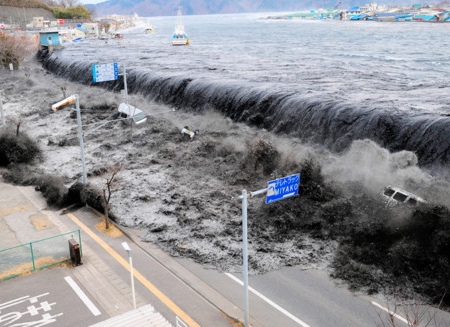Feature: Tsunami Waves’ Destructive Power

A tsunami surged over a seawall and deluged the Japanese city of Miyako.
Water is surprisingly heavy. According to New York Times science writer Kenneth Chang, “A typical bathtub holds 40 gallons or so of water. That is 330 pounds. A cubic yard of it, filling what at first glance seems a modest volume of 3 feet by 3 feet by 3 feet, weighs nearly 1,700 pounds, as much as the Smart micro car.”
When in motion, such as in a tsunami wave created by an earthquake, landslide, or glacier breakage, that water can easily kill. The tsunami that hit Northern Japan on Friday is an eye-opening example of the power water can have—and the devastation it can bring.
Florida State’s Philip Froelich, an oceanography professor, says that tsunami waves operate “like a solid hammer.” Water in a tsunami slams into large walls at full force but slips around some rounder objects. Unprotected humans and most structures have few defenses against it. “It’s basically like a hundred tanks coming across you,” Froelich says.
Tsunami waves also gather debris—from dirt and trees to cars, houses, and boats—and fling it at everything in the way. “Those added projectiles can create more destruction as they crash into other objects,” Chang writes. “Even if the wave only comes up to the knees, the force is enough to knock a person down.”
A tsunami’s power can be explained through physics. Earthquakes on the sea floor push part of it up or down, which changes the height of the water above, creating potential energy. That potential energy becomes kinetic energy of tsunami waves.
Friday’s earthquake moved a 250-mile-long section of sea floor one yard on average. Water in the billions of cubic yards, which works out to trillions of pounds, suddenly shifted its position. The energy that went into the tsunami created by this shift equals just short of the amount used in the explosion of an atomic bomb.
Read the full New York Times article by Kenneth Chang here.
Filed under: Special Features
Tags: Japan, Ocean, Ocean science, Physics, Water








